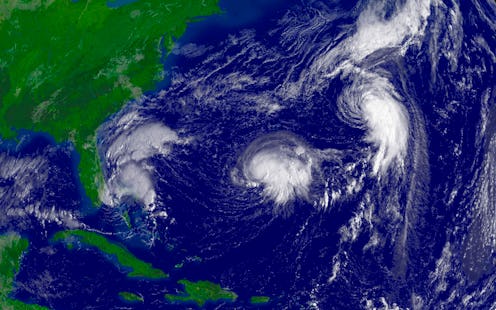
On Monday evening, Hurricane Maria made landfall on the small Caribbean island of Dominica, with reportedly devastating consequences. Now, you may be wondering where the storm will head next. Unfortunately, Hurricane Maria's trajectory looks pretty devastating for parts of the Caribbean, including the U.S. territories of Puerto Rico and the U.S. Virgin Islands.
Maria struck Dominica on Monday evening as a Category 5 storm with extremely strong 160 mph winds (it has now been downgraded to a Category 4 storm). While the extent of the damage on the island is not yet known, Prime Minister Roosevelt Skerrit wrote on Facebook that the storm's impact appears catastrophic.
Initial reports are of widespread devastation. So far we have lost all what money can buy and replace. My greatest fear for the morning is that we will wake to news of serious physical injury and possible deaths as a result of likely landslides triggered by persistent rains.
So, far the winds have swept away the roofs of almost every person I have spoken to or otherwise made contact with. The roof to my own official residence was among the first to go and this apparently triggered an avalanche of torn away roofs in the city and the countryside.
After directly striking Dominica, Maria is expected to continue on its Caribbean trajectory over many of the Leeward Islands, as well as Puerto Rico. Notably, some of these islands were recently profoundly impacted by Hurricane Irma. According to the latest update from the National Hurricane Center, the following islands are all under hurricane warnings:
- Dominica
- Guadeloupe
- St. Kitts & Nevis
- Montserrat
- U.S. Virgin Islands
- British Virgin Islands
- Puerto Rico, Culebra, and Vieques
Moreover, several other islands are also under hurricane watches, including St. Martin/St. Maarten, which was absolutely devastated by Hurricane Irma.
The U.S. territories of Puerto Rico and the Virgin Islands stand to be profoundly impacted by the storm. Maria could potentially hit the U.S. Virgin Islands on Tuesday evening and Puerto Rico on Wednesday morning. A hurricane alert issued by the National Weather Service indicated that Maria could produce exceedingly high amounts of rainfall in the U.S. territories, with total accumulations of 12 to 18 inches expected in most areas of the islands — and some places receiving up to 25 inches or more. This rainfall, coupled with the risk of significant storm surge, or sea level rise, could result in deadly flooding on the islands.
Moreover, the alert also warned that both territories could endure extremely high winds during the hurricane, which could cause severe damage to buildings and power and communications infrastructure — and put people's lives at risk.
The National Hurricane Center also did not mince words when it came to describing the threat posed by Maria to the U.S. Virgin Islands, Puerto Rico, and several other Caribbean islands.
Maria will affect portions of the Leeward Islands and the British and U.S. Virgin Islands ... [and] is likely to affect Puerto Rico as an extremely dangerous major hurricane.
Life-threatening flash floods and mudslides from heavy rainfall are expected across the Leeward Islands, including Puerto Rico and the U.S. and British Virgin Islands.
Both Puerto Rico and the U.S. Virgin Islands have declared states of emergency in anticipation of Hurricane Maria, which have been approved by the U.S. government. This means that U.S. federal funds are now accessible for disaster relief and recovery in the territories.
According to ABC News, after Maria moves through Puerto Rico and the U.S. and British Virgin Islands, it is expected to brush past the Dominican Republic, though not strike it directly. It is then anticipated that Maria will move toward the British islands of Turks and Caicos and then out to the Atlantic Ocean. Current hurricane models do not show Maria striking Florida or other parts of the mainland United States; however, it is important to keep in mind that models are not a guarantee of the path that the storm will take.
You can be sure that people are anxiously watching from near and far as the storm moves through the region — and hoping that the damage resulting from the storm is much less than anticipated, especially since many places in Maria's path are still trying to recover from Irma's destruction.